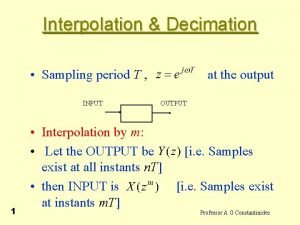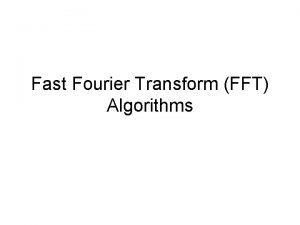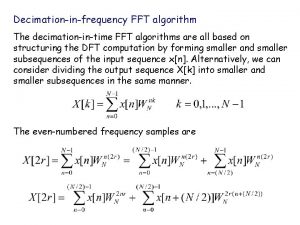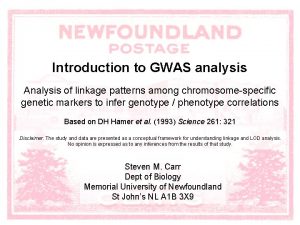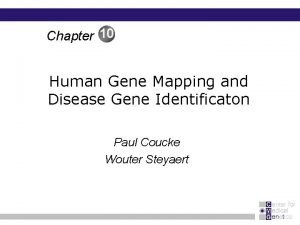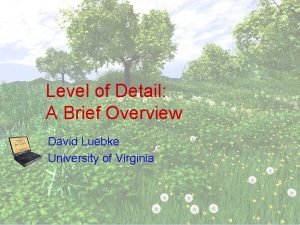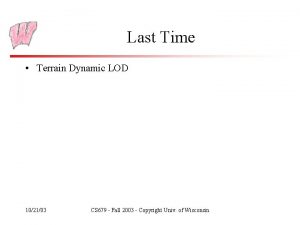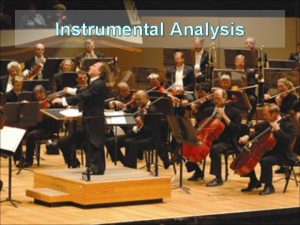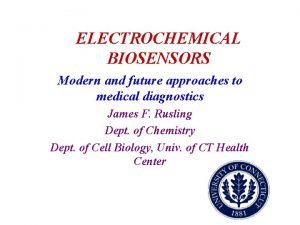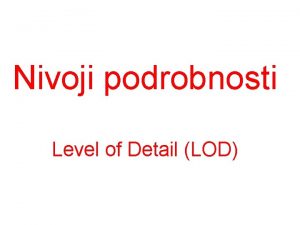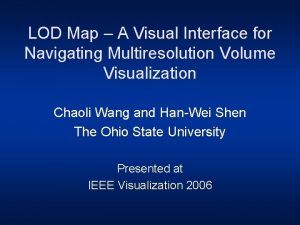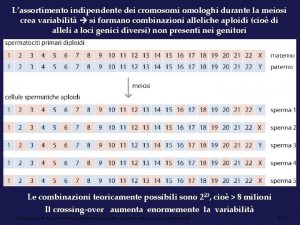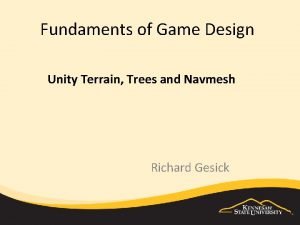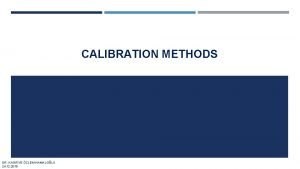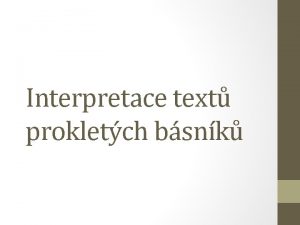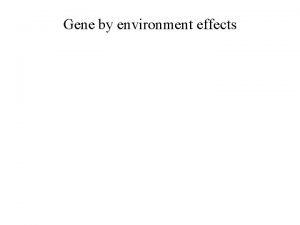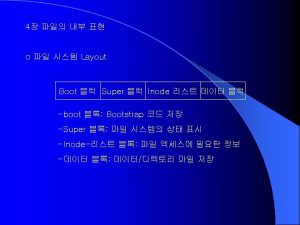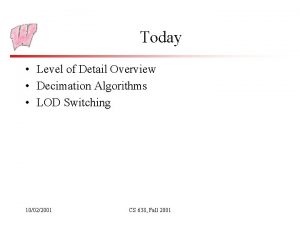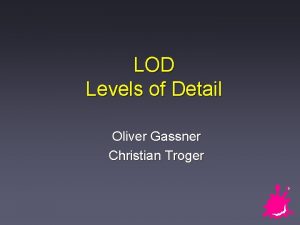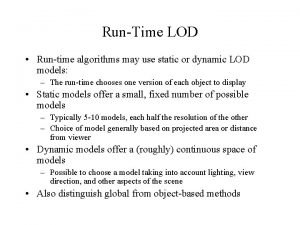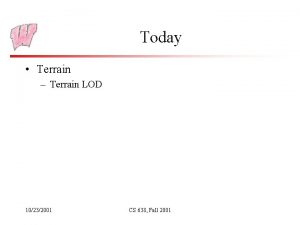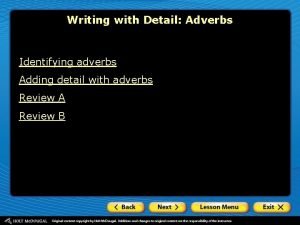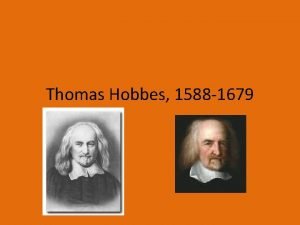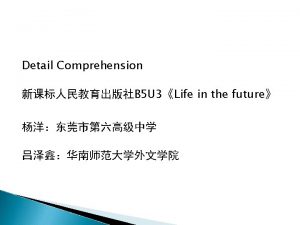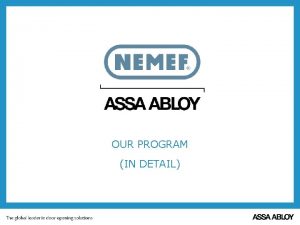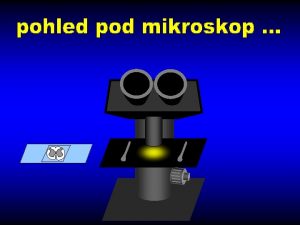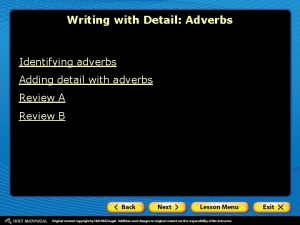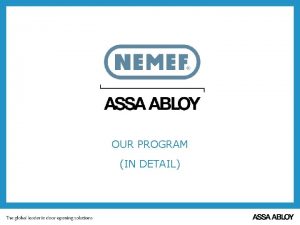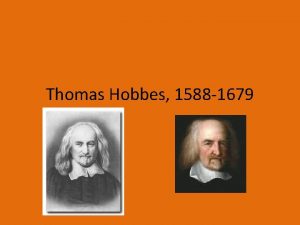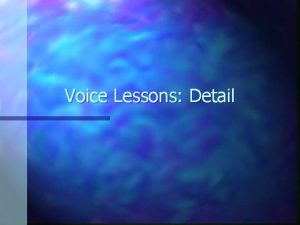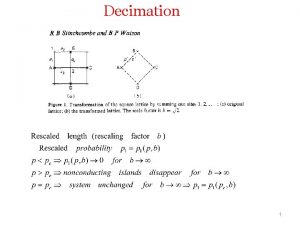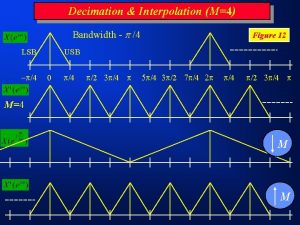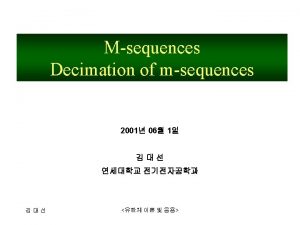Today Level of Detail Overview Decimation Algorithms LOD







![Vertex Clustering • Partition space into cells – grids [Rossignac-Borrel], spheres [Low-Tan], octrees, . Vertex Clustering • Partition space into cells – grids [Rossignac-Borrel], spheres [Low-Tan], octrees, .](https://slidetodoc.com/presentation_image_h2/17e738f49e404d402a2f95fa9c589959/image-8.jpg)




















- Slides: 28

Today • Level of Detail Overview • Decimation Algorithms • LOD Switching 10/02/2001 CS 638, Fall 2001

Level of Detail (LOD) • When an object is close to the viewer, we want a high resolution model – Maybe thousands of polygons, high-res textures • When an object is a long way away, it maps to relatively few screen pixels, so we want a low resolution model – Maybe only a single polygon, or tens of polygons • Level of Detail (LOD) techniques draw models at different resolutions depending on their relevance to the viewer – Covers both the generation of the models and how they are displayed – A very active research topic, so only a small part of it in this class 10/02/2001 CS 638, Fall 2001

LOD Models (I) 10/02/2001 CS 638, Fall 2001

LOD Models (II) 10/02/2001 CS 638, Fall 2001

Standard LOD • The current standard for LOD in games is to use a finite set of models – Typically aim for models with n, n/2, n/4, … polygons – Models may be hand generated or come from automatic decimation of the base mesh (highest resolution) • Models are switched based on the distance from the object to the viewer, or projected screen size – Better metric is visual importance, but it is harder to implement • For example, objects that the viewer is likely to be looking at have higher resolution, objects at periphery have lower resolution – Textbook Ch 4. 9 has another switching factor - Magnification 10/02/2001 CS 638, Fall 2001

Mesh Decimation • Take a high resolution base mesh and approximate it while retaining its visual appearance • Desirable properties: – – Fast (although not real-time) Generates “good” approximations in some sense Handles a wide variety of input meshes Allows for geomorphs - geometric blending from one mesh to another • Two essential questions: – What operations are used to reduce the mesh complexity? – How is “good” measured and used to guide the approximation? 10/02/2001 CS 638, Fall 2001

Mesh Operations • Operations seek to eliminate triangles while maintaining appearance. Key questions: – What does the operation do? – Can it connect previously unconnected parts of the mesh? • Does it change the mesh topology? – How much does it assume about the mesh structure? • Must the mesh be manifold (locally isomorphic to a disc)? • Can it handle, or does it produce, degenerate meshes? – Can it be construed as a morph? • Can it be animated smoothly? 10/02/2001 CS 638, Fall 2001
![Vertex Clustering Partition space into cells grids RossignacBorrel spheres LowTan octrees Vertex Clustering • Partition space into cells – grids [Rossignac-Borrel], spheres [Low-Tan], octrees, .](https://slidetodoc.com/presentation_image_h2/17e738f49e404d402a2f95fa9c589959/image-8.jpg)
Vertex Clustering • Partition space into cells – grids [Rossignac-Borrel], spheres [Low-Tan], octrees, . . . • Merge all vertices within the same cell – triangles with multiple corners in one cell will degenerate Slide courtesy Michael Garland, http: //graphics. uiuc. edu/~garland 10/02/2001 CS 638, Fall 2001

Vertex Decimation • Starting with original model, iteratively – rank vertices according to their importance – select unimportant vertex, remove it, retriangulate hole • A fairly common technique – Schroeder et al, Soucy et al, Klein et al, Ciampalini et al Slide courtesy Michael Garland, http: //graphics. uiuc. edu/~garland 10/02/2001 CS 638, Fall 2001

Iterative Contraction • Contraction can operate on any set of vertices – edges (or vertex pairs) are most common, faces also used • Starting with the original model, iteratively – rank all edges with some cost metric – contract minimum cost edge – update edge costs Slide courtesy Michael Garland, http: //graphics. uiuc. edu/~garland 10/02/2001 CS 638, Fall 2001

Edge Contraction • Single edge contraction (v 1, v 2) v’ is performed by – moving v 1 and v 2 to position v’ – replacing all occurrences of v 2 with v 1 – removing v 2 and all degenerate triangles v’ v 2 v 1 Slide courtesy Michael Garland, http: //graphics. uiuc. edu/~garland 10/02/2001 CS 638, Fall 2001

Vertex Pair Contraction • Can also easily contract any pair of vertices – fundamental operation is exactly the same – joins previously unconnected areas – can be used to achieve topological simplification Slide courtesy Michael Garland, http: //graphics. uiuc. edu/~garland 10/02/2001 CS 638, Fall 2001

Operations to Algorithms • A single operation doesn’t reduce a mesh! • Most common approach is a greedy algorithm built on edge contractions (iterative edge contractions): – Rank each possible edge contraction according to how much error it would introduce – Contract edge that introduces the least error – Repeat until done • Does NOT produce optimal meshes – An optimal mesh for a given target number of triangles is the one with the lowest error with respect to the original mesh – Finding the optimal mesh is NP-hard (intractable) 10/02/2001 CS 638, Fall 2001

Error Metrics • The error metric measures the error introduced by contracting an edge – Should be low for edges whose removal leaves mesh nearly unchanged • What is an example of an edge that can be removed without introducing any error? • Issues: – How well does it measure changes in appearance? – How easy is it to compute? • Subtle point: Error should be measured with respect to original mesh, which can pose problems – Can it handle color and other non-geometric attributes? 10/02/2001 CS 638, Fall 2001

Measuring Error With Planes • An edge contraction moves two vertices to a single new location • Measure how far this location is from the planes of the original faces • 2 D examples (planes are lines): High error Low error 10/02/2001 CS 638, Fall 2001

Which Planes? • Each vertex has a (conceptual) set of planes – Error sum of squared distances to planes in set – Each plane given by normal, ni, and distance to origin, di • Initialize with planes of incident faces – Consequently, all initial errors are 0 • When contracting pair, use plane set union – planes(v’) = planes(v 1) planes(v 2) 10/02/2001 CS 638, Fall 2001

The Quadric Error Metric • Given a plane, we can define a quadric Q measure squared distance to the plane as 10/02/2001 CS 638, Fall 2001

The Quadric Error Metric • Sum of quadrics represents set of planes • Each vertex has an associated quadric – Error(vi) = Qi (vi) – Sum quadrics when contracting (vi, vj) v’ – Error introduced by contraction is Q(v’) 10/02/2001 CS 638, Fall 2001

Where Does v’ Belong? • Choose the location for v’ that will minimize the error introduced • Alternative is to use fixed placement: – – Select v 1 or v 2 Fixed placement is faster but lower quality But it also gives smaller progressive meshes (more later) Fallback to fixed placement if A is non-invertible • When is A non-invertible (hard!)? 10/02/2001 CS 638, Fall 2001

Visualizing Quadrics in 3 -D • Quadric isosurfaces – Contain all the vertex locations that are within a given distance of the face planes – Are ellipsoids (maybe degenerate) – Centered around vertices – Characterize shape – Stretch in least-curved directions 10/02/2001 CS 638, Fall 2001

Sample Model: Dental Mold 50 sec 424, 376 faces 10/02/2001 60, 000 faces CS 638, Fall 2001

Sample Model: Dental Mold 55 sec 424, 376 faces 10/02/2001 8000 faces CS 638, Fall 2001

Sample Model: Dental Mold 56 sec 424, 376 faces 10/02/2001 1000 faces CS 638, Fall 2001

Must Also Consider Attributes Mesh for solution 10/02/2001 Radiosity solution CS 638, Fall 2001

Must Also Consider Attributes • Add extra terms to plane equations for color information (or texture coords) • Makes matrices and vectors bigger, but doesn’t change overall approach 50, 761 faces 10/02/2001 CS 638, Fall 2001 10, 000 faces

LOD Switching • The biggest issue with switching is popping, the sudden change in visual appearance as the models are swapped – Particularly poor if the object is right at the switching distance – may flicker badly • There are several options: – Leave the popping but try to avoid flicker: Textbook Ch 4. 9 – Show a blended combination of two models, based on the distance between the switching points • Image blend – render two models at alpha 0. 5 each • Geometric blend – define a way to geometrically morph from one model to the next, and blend the models – Have more models that are so similar that the popping is not evident 10/02/2001 CS 638, Fall 2001

Hysteresis Thresholds (Gems Ch 4. 9) • The aim is to avoid rapid popping if the object straddles the threshold for switching • Define two thresholds for each switch, distance as the metric – One determines when to improve the quality of the model – The other determines when to reduce it – The reduction threshold should be at a greater distance than the increase threshold – If the object is between the thresholds, use the same LOD as on the previous frame 10/02/2001 CS 638, Fall 2001

Hysteresis Illustration • Say there is an object that repeatedly jumps from one position to a nearer one and then back again – How far must it jump to exhibit popping? • One way to think about it: If you’re on one level, you can only ride the arrows to the next level LOD Tincrease 10/02/2001 Tdecrease CS 638, Fall 2001 Distance
 Decimation rate
Decimation rate Interpolation and decimation
Interpolation and decimation Dit fft algorithm
Dit fft algorithm Fft decimation in frequency
Fft decimation in frequency Major details and minor details
Major details and minor details Minor and major supporting details
Minor and major supporting details For todays meeting
For todays meeting Today's classes
Today's classes Proposal kickoff meeting agenda
Proposal kickoff meeting agenda Today lesson or today's lesson
Today lesson or today's lesson Today's lesson or today lesson
Today's lesson or today lesson Example of repitition
Example of repitition Difference between lod and sti in cmos
Difference between lod and sti in cmos How to calculate lod score
How to calculate lod score How to calculate lod score
How to calculate lod score Level of detail
Level of detail Dynamic lod
Dynamic lod Lod loq lol
Lod loq lol Lod test
Lod test Lod
Lod Lod map
Lod map Lod
Lod Unity terrain navmesh
Unity terrain navmesh Kadrye
Kadrye Lod
Lod Mne zabloudilou loď
Mne zabloudilou loď Lod score
Lod score Ialloc algorithm in unix
Ialloc algorithm in unix Lower level file system algorithms
Lower level file system algorithms

